Mmi AUDI A8 2003 D3 / 2.G Technical Features Manual
[x] Cancel search | Manufacturer: AUDI, Model Year: 2003, Model line: A8, Model: AUDI A8 2003 D3 / 2.GPages: 96, PDF Size: 5.51 MB
Page 4 of 96
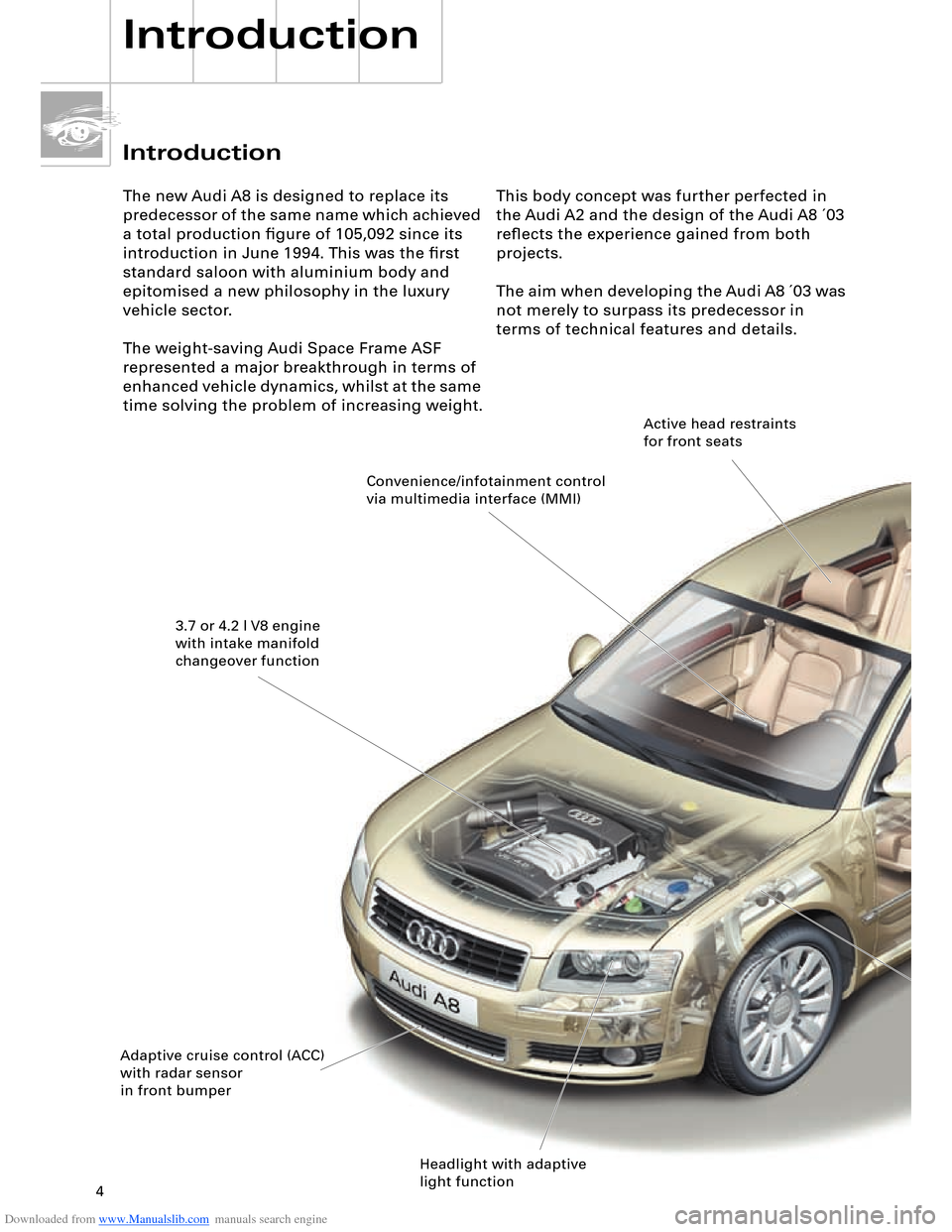
Downloaded from www.Manualslib.com manuals search engine 4
Introduction
The new Audi A8 is designed to replace its
predecessor of the same name which achieved
a total production figure of 105,092 since its
introduction in June 1994. This was the first
standard saloon with aluminium body and
epitomised a new philosophy in the luxury
vehicle sector.
The weight-saving Audi Space Frame ASF
represented a major breakthrough in terms of
enhanced vehicle dynamics, whilst at the same
time solving the problem of increasing weight.
Introduction
This body concept was further perfected in
the Audi A2 and the design of the Audi A8 ´03
reflects the experience gained from both
projects.
The aim when developing the Audi A8 ´03 was
not merely to surpass its predecessor in
terms of technical features and details.
Convenience/infotainment control
via multimedia interface (MMI)
3.7 or 4.2 l V8 engine
with intake manifold
changeover function
Adaptive cruise control (ACC)
with radar sensor
in front bumper
Headlight with adaptive
light functionActive head restraints
for front seats
Page 51 of 96
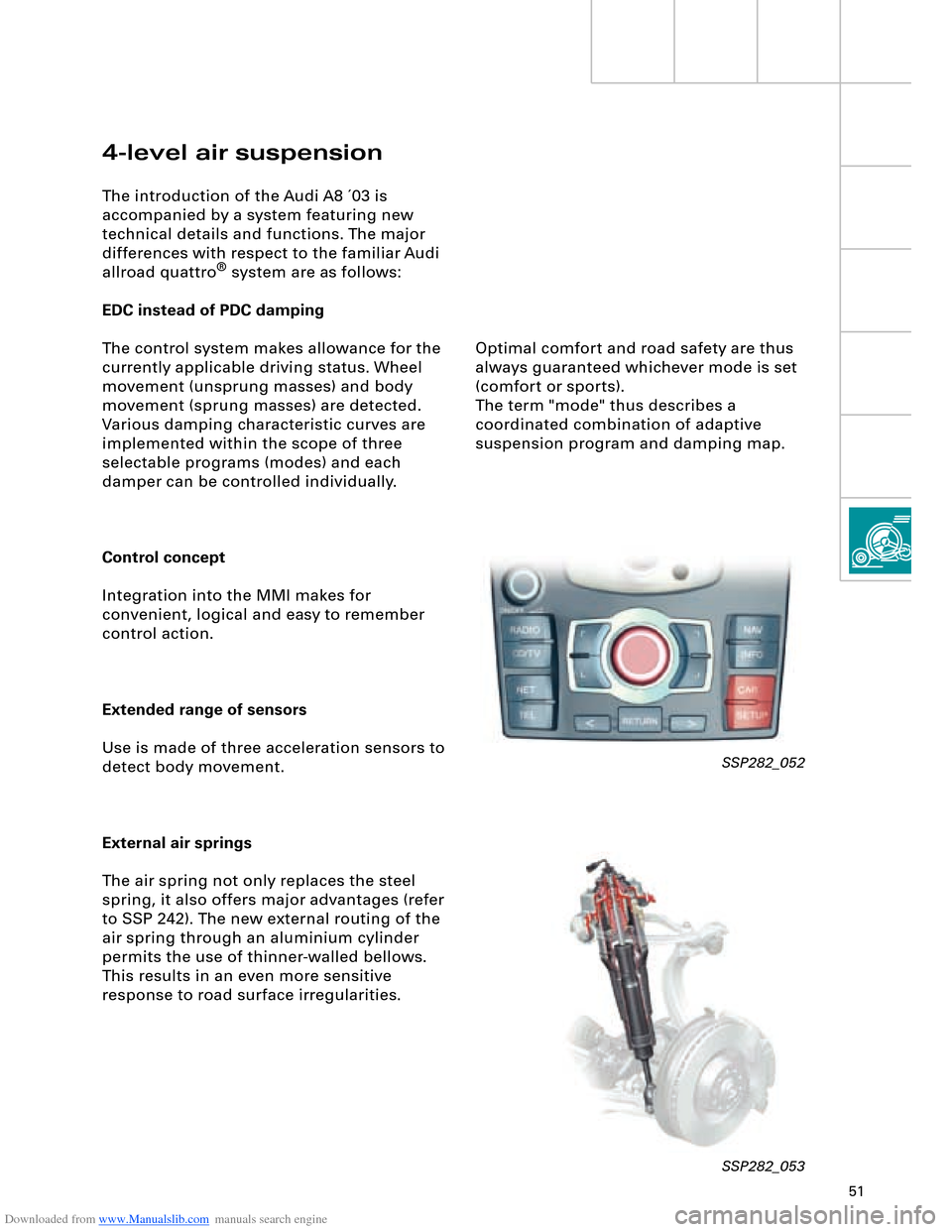
Downloaded from www.Manualslib.com manuals search engine 51
4-level air suspension
The introduction of the Audi A8 ´03 is
accompanied by a system featuring new
technical details and functions. The major
differences with respect to the familiar Audi
allroad quattro
® system are as follows:
EDC instead of PDC damping
The control system makes allowance for the
currently applicable driving status. Wheel
movement (unsprung masses) and body
movement (sprung masses) are detected.
Various damping characteristic curves are
implemented within the scope of three
selectable programs (modes) and each
damper can be controlled individually.
Control concept
Integration into the MMI makes for
convenient, logical and easy to remember
control action.
Extended range of sensors
Use is made of three acceleration sensors to
detect body movement.
External air springs
The air spring not only replaces the steel
spring, it also offers major advantages (refer
to SSP 242). The new external routing of the
air spring through an aluminium cylinder
permits the use of thinner-walled bellows.
This results in an even more sensitive
response to road surface irregularities.
SSP282_052
SSP282_053
Optimal comfort and road safety are thus
always guaranteed whichever mode is set
(comfort or sports).
The term "mode" thus describes a
coordinated combination of adaptive
suspension program and damping map.
Page 65 of 96

Downloaded from www.Manualslib.com manuals search engine 65
Multifunction steering wheel
A new multifunction steering wheel has been
introduced as standard. This is equipped with
special paddles (as used in formula 1 and for
the Le Mans R8) for manual shifting of the
6-speed Tiptronic
®. The voice control option
for radio, CD changer, telephone, navigation
system and MMI address book can also be
operated by way of the multifunction steering
wheel.
Dash panel insert display
Selection menu for:
– Radio station
– CD track
– Telephone address book
– Navigation system information
display
SSP282_086
Press MODE button:
For telephone, navigation system and
radio/CD menu selection
Turn left function control:
To select menu item
Press left function control:
For selection within chosen menu item
To accept a telephone callPress PTT (push to talk) button:
To activate/deactivate voice control
Turn right function control:
To regulate volume
Press right function control:
To repeat last navigation system message
Volume level/navigation
message repetition
control
Voice control
start/termination
button MODE button Menu selection
controlPaddle –Paddle +
Page 72 of 96
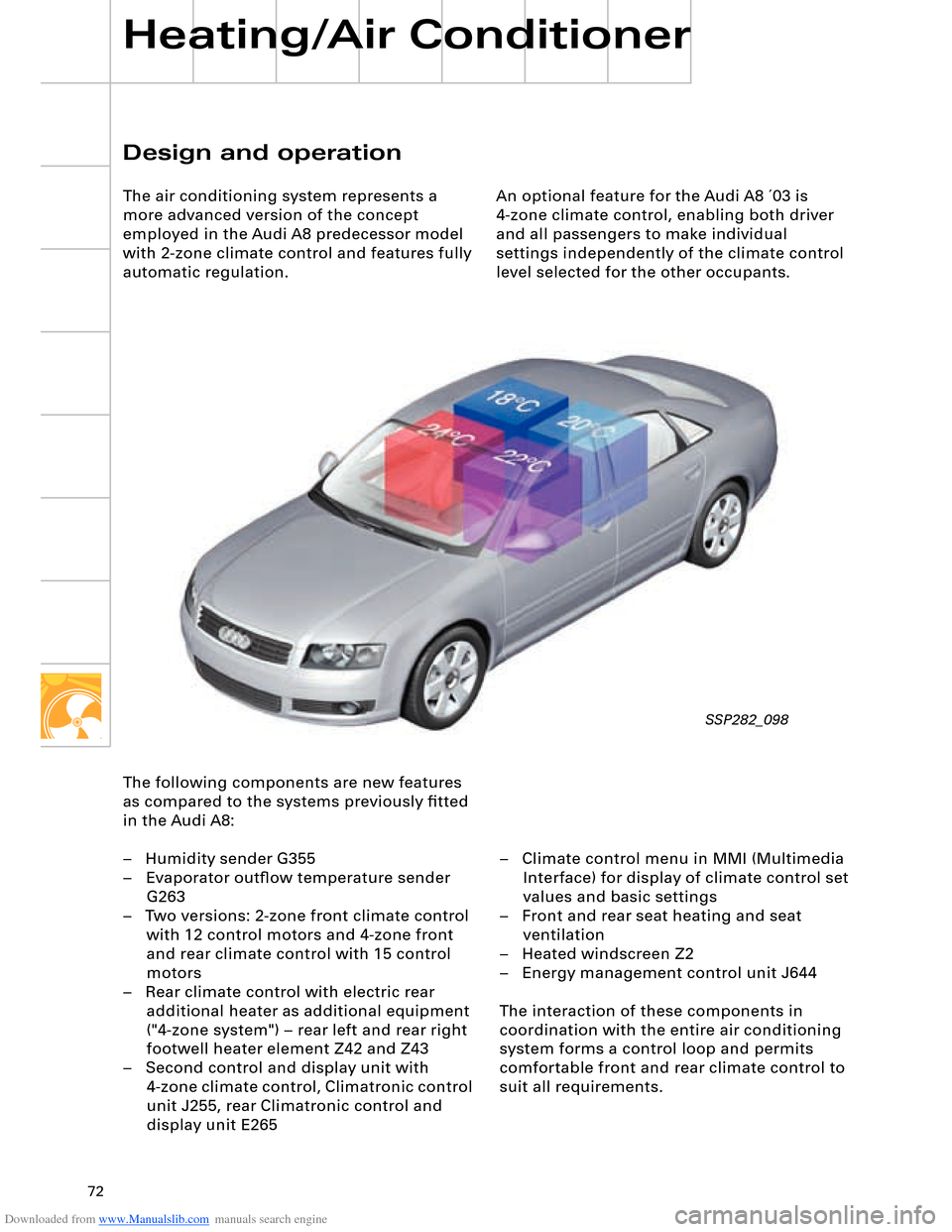
Downloaded from www.Manualslib.com manuals search engine 72
An optional feature for the Audi A8 ´03 is
4-zone climate control, enabling both driver
and all passengers to make individual
settings independently of the climate control
level selected for the other occupants.
Design and operation
The air conditioning system represents a
more advanced version of the concept
employed in the Audi A8 predecessor model
with 2-zone climate control and features fully
automatic regulation.
Heating/Air Conditioner
The following components are new features
as compared to the systems previously fitted
in the Audi A8:
– Humidity sender G355
– Evaporator outflow temperature sender
G263
– Two versions: 2-zone front climate control
with 12 control motors and 4-zone front
and rear climate control with 15 control
motors
– Rear climate control with electric rear
additional heater as additional equipment
("4-zone system") – rear left and rear right
footwell heater element Z42 and Z43
– Second control and display unit with
4-zone climate control, Climatronic control
unit J255, rear Climatronic control and
display unit E265– Climate control menu in MMI (Multimedia
Interface) for display of climate control set
values and basic settings
– Front and rear seat heating and seat
ventilation
– Heated windscreen Z2
– Energy management control unit J644
The interaction of these components in
coordination with the entire air conditioning
system forms a control loop and permits
comfortable front and rear climate control to
suit all requirements.
SSP282_098
Page 74 of 96
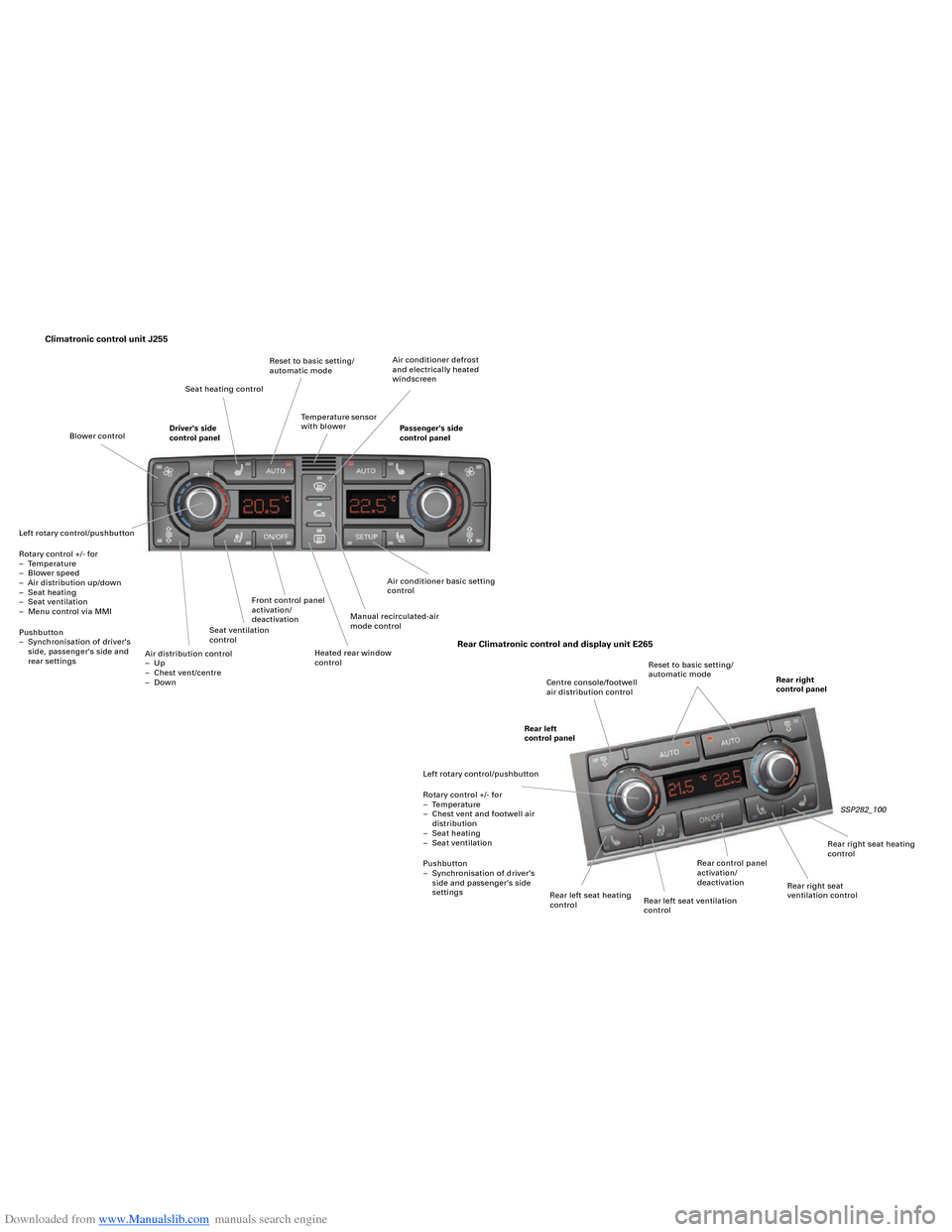
Downloaded from www.Manualslib.com manuals search engine Climatronic control unit J255
SSP282_100
Rear Climatronic control and display unit E265
Air conditioner basic setting
control
Heated rear window
control Front control panel
activation/
deactivation
Seat ventilation
control
Air distribution control
– Up
– Chest vent/centre
– Down Left rotary control/pushbutton
Rotary control +/- for
– Temperature
– Blower speed
– Air distribution up/down
– Seat heating
– Seat ventilation
– Menu control via MMI
Pushbutton
– Synchronisation of driver's
side, passenger's side and
rear settingsDriver's side
control panelPassenger's side
control panel Seat heating controlReset to basic setting/
automatic mode
Temperature sensor
with blowerAir conditioner defrost
and electrically heated
windscreen
Manual recirculated-air
mode control Blower control
Rear left
control panelCentre console/footwell
air distribution controlReset to basic setting/
automatic mode
Rear right
control panel
Left rotary control/pushbutton
Rotary control +/- for
– Temperature
– Chest vent and footwell air
distribution
– Seat heating
– Seat ventilation
Pushbutton
– Synchronisation of driver's
side and passenger's side
settings
Rear left seat heating
controlRear control panel
activation/
deactivation
Rear right seat
ventilation controlRear right seat heating
control
Rear left seat ventilation
control
Page 75 of 96
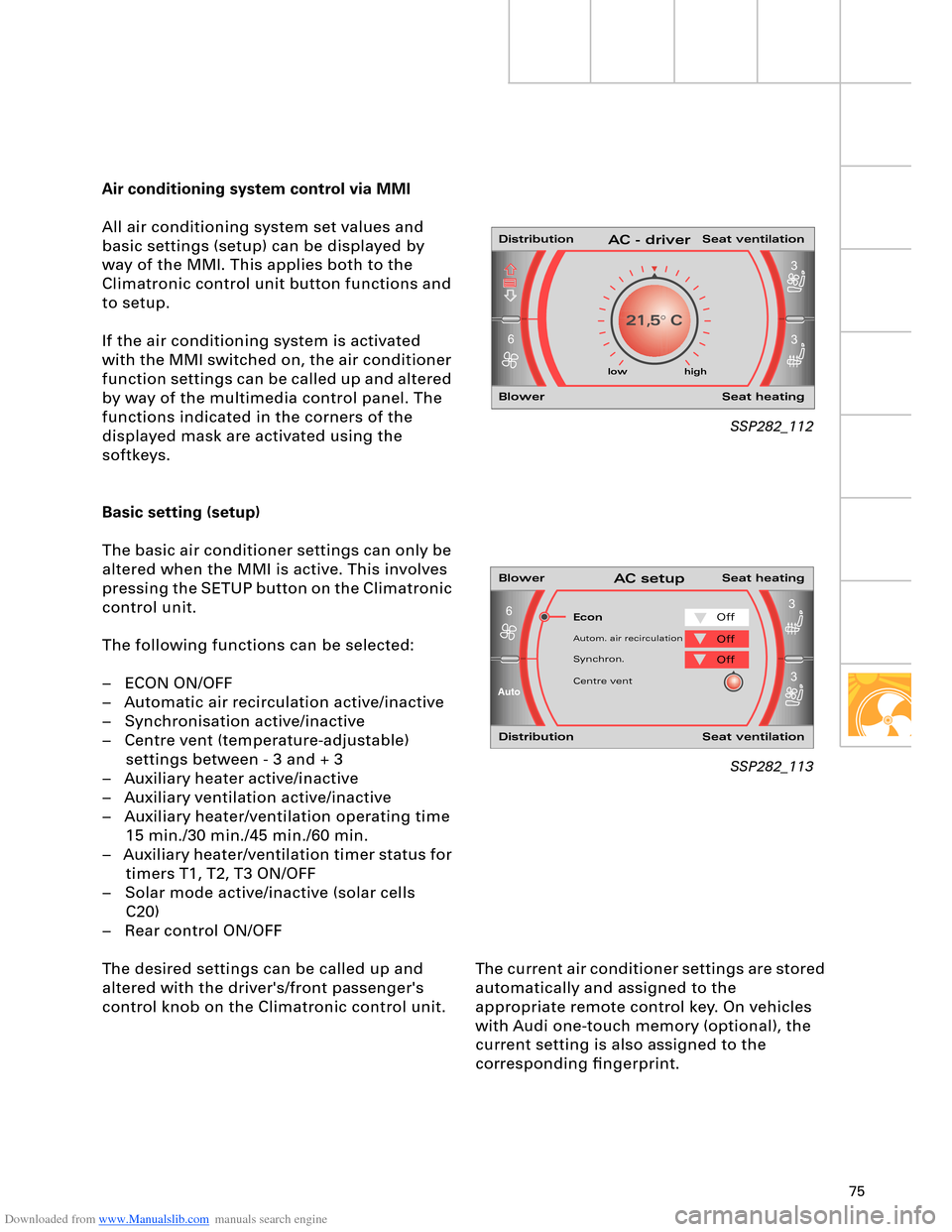
Downloaded from www.Manualslib.com manuals search engine 75
3
36
Auto
21,5° C
63
3
The current air conditioner settings are stored
automatically and assigned to the
appropriate remote control key. On vehicles
with Audi one-touch memory (optional), the
current setting is also assigned to the
corresponding fingerprint. Air conditioning system control via MMI
All air conditioning system set values and
basic settings (setup) can be displayed by
way of the MMI. This applies both to the
Climatronic control unit button functions and
to setup.
If the air conditioning system is activated
with the MMI switched on, the air conditioner
function settings can be called up and altered
by way of the multimedia control panel. The
functions indicated in the corners of the
displayed mask are activated using the
softkeys.
Basic setting (setup)
The basic air conditioner settings can only be
altered when the MMI is active. This involves
pressing the SETUP button on the Climatronic
control unit.
The following functions can be selected:
– ECON ON/OFF
– Automatic air recirculation active/inactive
– Synchronisation active/inactive
– Centre vent (temperature-adjustable)
settings between - 3 and + 3
– Auxiliary heater active/inactive
– Auxiliary ventilation active/inactive
– Auxiliary heater/ventilation operating time
15 min./30 min./45 min./60 min.
– Auxiliary heater/ventilation timer status for
timers T1, T2, T3 ON/OFF
– Solar mode active/inactive (solar cells
C20)
– Rear control ON/OFF
The desired settings can be called up and
altered with the driver's/front passenger's
control knob on the Climatronic control unit.
SSP282_112
SSP282_113
low high
Econ
Distribution Seat ventilation
Blower Seat heatingAC - driver
Blower Seat heatingAC setup
Distribution Seat ventilation
Off
Autom. air recirculationOff
Synchron.Off
Centre vent
Page 84 of 96
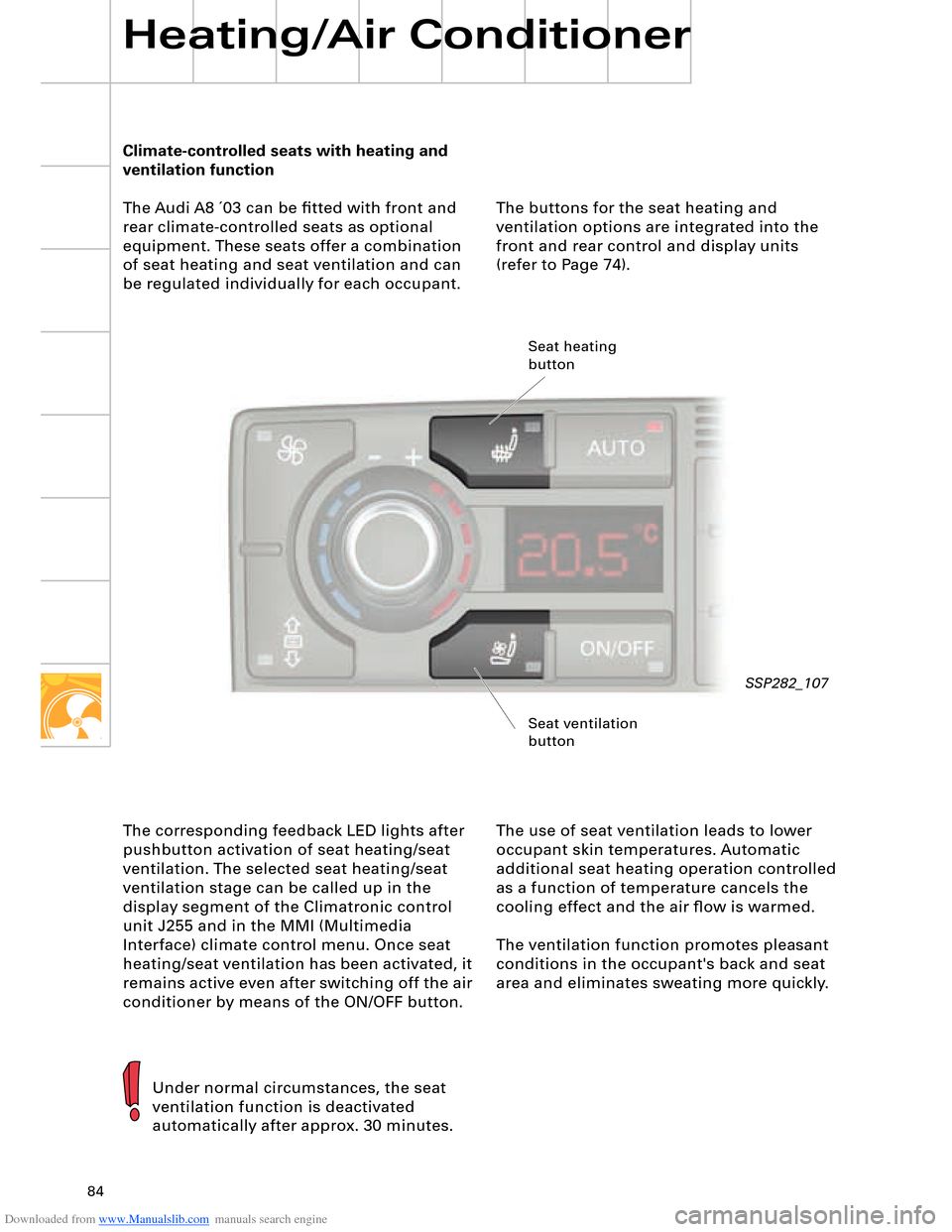
Downloaded from www.Manualslib.com manuals search engine 84
The buttons for the seat heating and
ventilation options are integrated into the
front and rear control and display units
(refer to Page 74). Climate-controlled seats with heating and
ventilation function
The Audi A8 ´03 can be fitted with front and
rear climate-controlled seats as optional
equipment. These seats offer a combination
of seat heating and seat ventilation and can
be regulated individually for each occupant.
Heating/Air Conditioner
The corresponding feedback LED lights after
pushbutton activation of seat heating/seat
ventilation. The selected seat heating/seat
ventilation stage can be called up in the
display segment of the Climatronic control
unit J255 and in the MMI (Multimedia
Interface) climate control menu. Once seat
heating/seat ventilation has been activated, it
remains active even after switching off the air
conditioner by means of the ON/OFF button.The use of seat ventilation leads to lower
occupant skin temperatures. Automatic
additional seat heating operation controlled
as a function of temperature cancels the
cooling effect and the air flow is warmed.
The ventilation function promotes pleasant
conditions in the occupant's back and seat
area and eliminates sweating more quickly.
Under normal circumstances, the seat
ventilation function is deactivated
automatically after approx. 30 minutes.
SSP282_107 Seat heating
button
Seat ventilation
button
Page 90 of 96
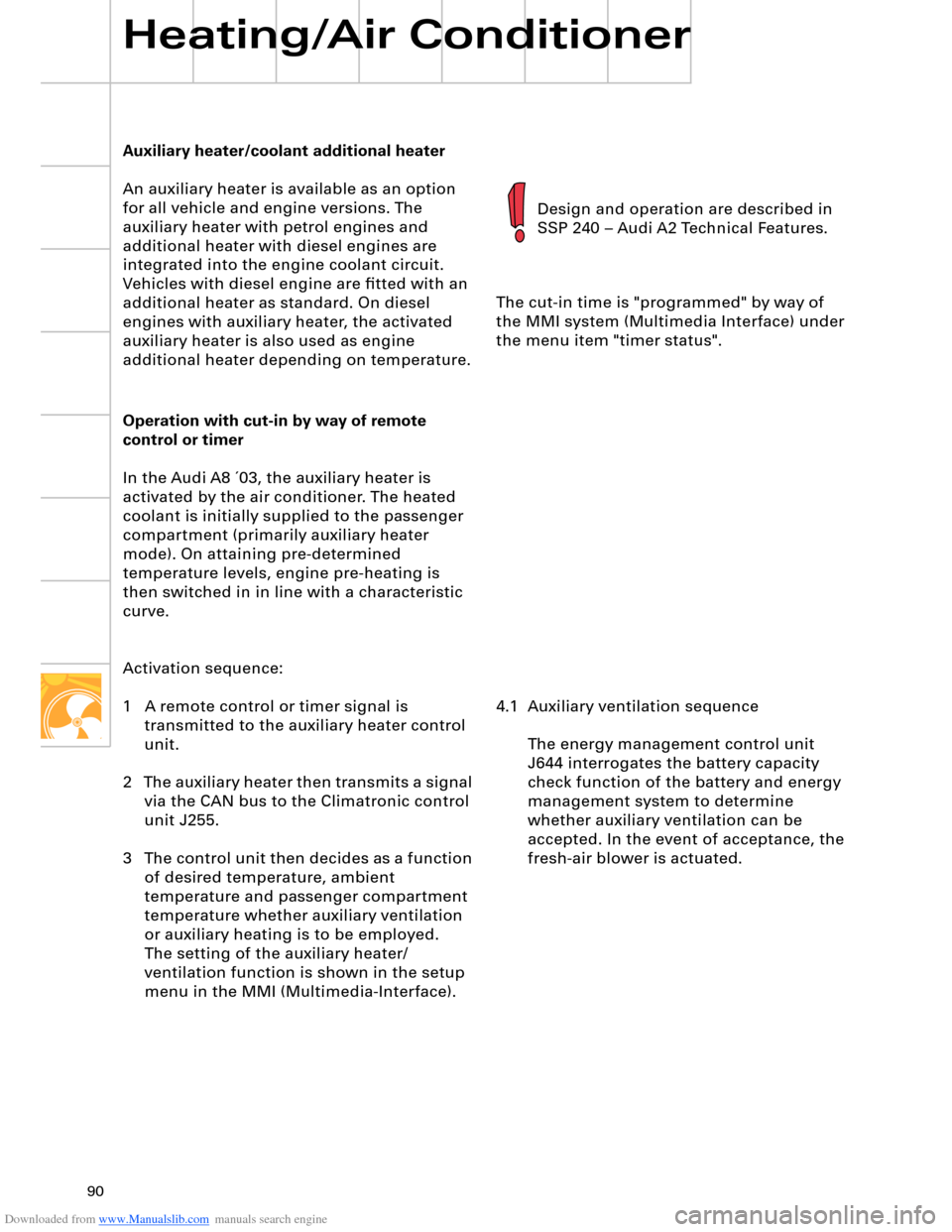
Downloaded from www.Manualslib.com manuals search engine 90
Auxiliary heater/coolant additional heater
An auxiliary heater is available as an option
for all vehicle and engine versions. The
auxiliary heater with petrol engines and
additional heater with diesel engines are
integrated into the engine coolant circuit.
Vehicles with diesel engine are fitted with an
additional heater as standard. On diesel
engines with auxiliary heater, the activated
auxiliary heater is also used as engine
additional heater depending on temperature.
Heating/Air Conditioner
Design and operation are described in
SSP 240 – Audi A2 Technical Features.
Operation with cut-in by way of remote
control or timer
In the Audi A8 ´03, the auxiliary heater is
activated by the air conditioner. The heated
coolant is initially supplied to the passenger
compartment (primarily auxiliary heater
mode). On attaining pre-determined
temperature levels, engine pre-heating is
then switched in in line with a characteristic
curve.
Activation sequence:
1 A remote control or timer signal is
transmitted to the auxiliary heater control
unit.
2 The auxiliary heater then transmits a signal
via the CAN bus to the Climatronic control
unit J255.
3 The control unit then decides as a function
of desired temperature, ambient
temperature and passenger compartment
temperature whether auxiliary ventilation
or auxiliary heating is to be employed.
The setting of the auxiliary heater/
ventilation function is shown in the setup
menu in the MMI (Multimedia-Interface).The cut-in time is "programmed" by way of
the MMI system (Multimedia Interface) under
the menu item "timer status".
4.1 Auxiliary ventilation sequence
The energy management control unit
J644 interrogates the battery capacity
check function of the battery and energy
management system to determine
whether auxiliary ventilation can be
accepted. In the event of acceptance, the
fresh-air blower is actuated.
Page 91 of 96

Downloaded from www.Manualslib.com manuals search engine 91
4.2 Auxiliary heating sequence
The level of fuel in the tank is
interrogated. If the fuel tank is "empty",
the auxiliary heating function is not
permitted and the auxiliary heater symbol
in the dash panel insert goes out. "Empty"
roughly corresponds to the red display
zone. The energy management control
unit J644 checks whether there is
sufficient energy to accept auxiliary
heating. If this is the case, the auxiliary
heater is switched on in the various
operating modes depending on the
characteristic temperature curve and the
fresh-air blower is actuated.
If the auxiliary heating temperature
reaches a level of 30 °C, the fresh-air
blower is activated and the coolant
shutoff valve N279 pulsed in line with the
characteristic curve.
The auxiliary heater is switched off
automatically on completion of the operating
time transmitted by the MMI system to the
Climatronic control unit or it can be switched
off using the remote control OFF button.
Auxiliary heater circulation pump control
To speed up heating of the passenger
compartment and to achieve a better "heat
yield" in the air conditioner unit heat
exchanger, the circulation pump V55 and
coolant shutoff valve N279 are pulsed as a
function of water temperature and the
heating circuit flow rate is thus reduced.
An electric circulation pump is used for the
auxiliary heater. It is not possible to reduce
the supply voltage in the auxiliary heater
control unit and the circulation pump is thus
actuated at specific intervals to decrease its
output.
Additional control curve for "auxiliary heater"
and "additional heater"
When the engine is on, the auxiliary heater
and engine temperatures are constantly
compared. A switch to the large coolant
circuit is made as soon as the engine
temperature exceeds the auxiliary heater
temperature.
Activation of auxiliary heater circulation
pump with engine on
(pulsed operation of circulation pump)
In order to be able to ensure a sufficient flow
of water through the heat exchanger, the
auxiliary heater circulation pump must
additionally be switched on, as is the case for
instance with the 12-cylinder engine.If the engine is switched off again and not
all additional heater criteria (temperature,
time) are satisfied, the auxiliary heater
remains in operation for any residual
operating time before being deactivated.
This function can be encoded.